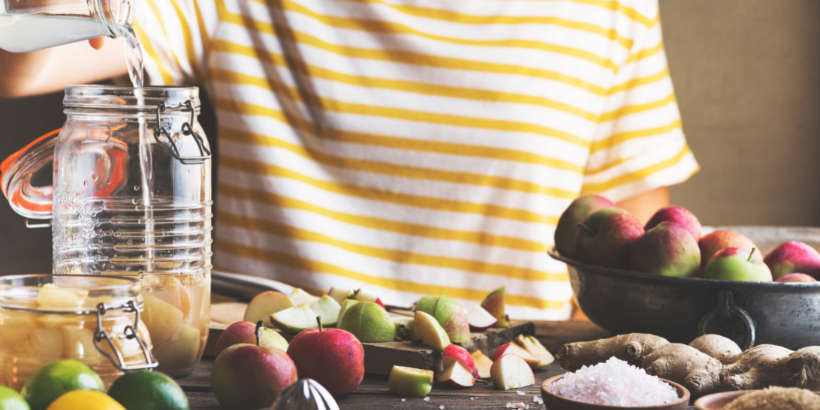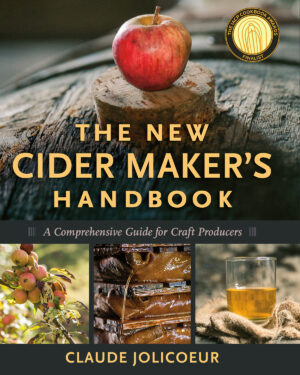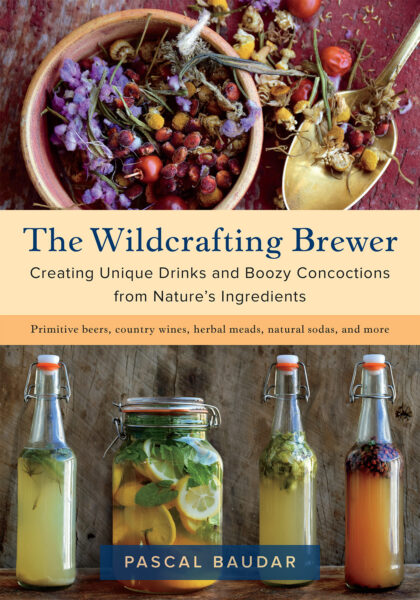Basics of Cider Making: Cider Preparation

To make the best cider, you first need an understanding of the processes and the art & science behind them. Thankfully, world-renowned cider maker Claude Jolicoeur is here to help. Become a cider making expert with help from these preparation tips!
The following is an excerpt from The New Cider Maker’s Handbook by Claude Jolicoeur. It has been adapted for the web.
Cider Making: Preparing Apple Cider
We could say that the preparation of the cider starts in the spring, because all the interactions between the trees, the environment, and the humans tending the trees influence the cider and its quality. The maturity of the apples at harvest and the degree of sweating will likewise have some effect. But for the present discussion, we will assume that everything mentioned above has been well done and that the apple juice (which we will now call the must) is already in its primary fermentation vessel and ready to be transformed into cider.
1. Preparation for fermentation
- Sanitation
- Density and acidity measurements
- Additives: sulfite and pectinase
- Yeast culture and inoculation
2. Fermentation
- Primary phase
- First racking
- Secondary phase
3. Final racking, bottling, and in-bottle maturation
In the following description, I limit my discussion to a basic and well-proven method of making cider. I try to keep it as simple as possible and obtain a dry, natural cider, with perhaps some effervescence.
My objective is that you, the novice cider maker, will successfully make a good enough cider on your first trial that you will have the desire to persist and strive to produce even better ciders in the future.
Preparation for Fermentation
I recap here what is done to the must (juice) in preparation for the fermentation.
Sanitation
If you haven’t already done so, prepare your sulfite stock solution and your antiseptic solution. (See above on materials and supplies, and section 14.1 on sulfite.) All the materials—utensils, vessels, measuring instruments, siphon tubes, anything that will come into contact with the cider—should be perfectly clean.
Before use, sanitize all equipment by either soaking it in the antiseptic solution or by wiping or pouring some solution onto it. For containers, pour some solution inside and agitate so all interior surfaces get wetted. For a racking tube, pour some solution so it goes through the tube and wets all of the interior. Rinse with clear water and let drain a few minutes. Note that some sanitizers don’t require rinsing.
Density and Acidity Measurements
These measurements are not absolutely necessary and will not make the cider any better; however, I strongly recommend you make them to learn about their influence on the final product. The hydrometer is used to measure the density of the must, usually expressed as specific gravity (SG). This allows you to estimate the quantity of sugar and the final alcoholic strength that the cider will have when fully fermented.
The measurement of the pH is necessary only for the dosage of sulfite to the must (see the following section “Sulfite treatment”). And the total acidity (TA) will give you some clue in relation to the acidity sensation you experience when you taste the cider. For example, if you measure 7.5 grams of malic acid per liter, and you think the finished cider is too sharp, then you will know for next time to start with a blend that has a lower total acidity.
Sulfite Treatment
Sulfite addition to the must is strongly recommended for your first trials at cider making in order to kill or inhibit wild and spoiling yeasts and bacteria. It should be done as soon as possible after pressing. If you have measured the pH of the must, you can add the recommended amount of sulfite as a function of the acidity. If you don’t know the pH and use mainly North American eating apples that are fairly sharp, a dosage of 40 to 50 ppm of sulfur dioxide (SO2) is usually adequate.
For a 5-gallon batch, this level is achieved by adding 1.8 grams (a bit less than 1⁄2 teaspoon) of potassium metabisulfite, first dis- solved in a little water or juice, then mixed with the must. If you use apples that are sweeter and haven’t much sharpness, you may double this dos- age. Alternatively, you may use Campden tablets: four tablets dissolved in a 5-gallon batch will give 50 ppm of SO2. However, be warned that these tablets don’t dissolve easily and need to be broken up into powder before trying to dissolve them in water or juice.
Caution: Do not drink the freshly sulfited juice. Also, avoid smelling the fumes coming from the sulfite solution.
Pectinase Addition
Pectic enzyme, or pectinase, breaks the pectin chains in the juice, and this will help the cider to clear once the fermentation is completed. Most of the time, the cider will clear (or “fall bright”) naturally when it’s done, even if a pectic enzyme hasn’t been used. However, if the must contains a lot of pectin, then this treatment acts a bit like an insurance policy, improving the odds that you will obtain a perfectly clear cider.
There are many such products on the market, and they don’t all have the same activity, so you will need to follow the dosage instructions that came with the particular product you have bought. Simply add the required quantity of pectinase to the must, making sure you dilute it first in a small quantity of juice, and stir. This addition may be done just after the sul- fite treatment. Other types of treatments that may be done on pectin are covered in the article “The Pectic Substances,” chapter 12.
Yeast Culture and Inoculation
The objective when adding yeast is to introduce a strong population of a selected pure yeast strain whose main characteristics are well known. For cider, there are many yeast strains that will give excellent results, most being wine yeasts, and this is a vast area for experimentation. The use of cultured yeast often goes along with a sulfite treatment. The principle is as follows: with the sulfite, we kill off (or greatly suppress) bacteria and wild yeasts, and then we introduce the selected yeast that will take over the fermentation and give the character we want for the cider. Without a sulfite treatment, the wild yeasts may give unpredictable flavors to the cider. This can sometimes be for the better, but not always.
Caution: After a sulfite treatment, it is necessary to wait a minimum of twenty-four hours before adding a yeast culture to the juice, as a freshly sulfited must is toxic for the yeasts.
For your first trials at making cider, I would recommend a champagne strain of dried yeast. This is one of the most common types and is considered an all-purpose yeast. It is inexpensive, gives excellent results in cider, and is sold in small packages sized for a 5-gallon batch in all wine- making supply stores.
Using Dried Yeast
Dried yeast needs to be rehydrated before inoculation to the must. Instructions are on the package and essentially consist of emptying the contents of the package into a small quantity of warm water (105°F, or 40°C) and letting the yeast hydrate itself for about fifteen minutes. The mixture may then be stirred and poured into the must.
Once you have inoculated the must with the yeast, you need to cover the fermentation vessel. A hermetically sealed cover is not really necessary, because during the first phase of fermentation a lot of carbon dioxide gas is produced, which acts like a blanket and gives protection to the cider by preventing oxygen from coming into contact with the fermenting must. This said, I nonetheless prefer to use a cover that closes hermetically, and I install an airlock on it.
It might appear paradoxical that I recommend a relatively complex procedure for the novice cider maker to take in preparation for the fermentation, while the accomplished cider maker may simply let the must ferment naturally without any cultured yeasts or other and obtain an exquisite cider. However, you have to consider that this experienced cider maker acts with full knowledge of the facts (at least we hope so) and knows about the risks of getting a lower-quality cider. With experi- ence, he or she will be able to evaluate if a must is a good candidate for natural fermentation.
Cider Making Preparation: Fermentation
We generally consider the start of the fermentation to be the moment at which the yeast is introduced into the must. The fermentation phases are described in the article on monitoring and control of the fermentation, section 14.3, so I will give just a very short summary here.
Primary, or Turbulent, Phase
After the inoculation of yeast, there is a lag phase that may last a few hours to over a week, dur- ing which the yeast population establishes itself. Then the turbulent fermentation begins. A foam will form on top that may reach a couple of inches in thickness, white in the beginning, and later turning a brownish color. This foam will vanish after a week or two, leaving some brown deposits on the surface.
During this phase, you should visually check the cider about once a week. When the foam has gone and you can actually see the surface of the liquid, it is good practice to check the density again with a hydrometer and get a feeling for the fer- mentation speed of this particular batch of cider. If you have a fast fermentation, the specific gravity reading at this moment may be at 1.020 or lower, and you may then proceed with the first racking. If you have a slow fermentation, then the SG may be at 1.030 or higher. In this case you could delay the first racking until the SG reaches about 1.015.
First Racking
The first racking consists in moving the cider from the primary fermentation vessel to a secondary fermenter or carboy, while leaving the lees (the bottom sediment) undisturbed in the first vessel. The actual moving of the cider is usually done with a siphon (the racking tube) except in larger operations, where pumps are used.
The vessel from which you rack needs to be higher than the carboy that will receive the cider for the siphon to work. If this vessel is on the floor, you will need to put it on something higher, such as a table, at least a day before racking because you will disturb the lees while displacing the tank and they will need a bit of time to settle back to the bottom.
What to Do Before Racking
Before racking, you will need to sanitize with the antiseptic solution—as you would before any operation on the cider. You may then start the rack- ing process: insert the racking cane (the rigid part of the racking tube with a tip to prevent it from picking the lees) in the primary fermentation vessel, making sure you don’t disturb the lees. The best way to do this is to lower the cane so the tip is a couple of inches higher than the bottom and hold it there (an extra pair of hands or a rubber band may come in handy here).
Then prime the siphon by sucking the air from the end of the flexible tubing to create a vacuum: the cider will start to flow into the empty carboy. Some cider makers object to sucking air for priming the siphon, preferring either to use a small priming pump or to fill the flexible tube with clean water. However, there is no evidence that the microorganisms present in our mouths can survive in the cider, and most cider makers don’t bother with pumps. In any case, after a bit of practice, you will develop a racking procedure that works well for you.
Let the end of the flexible tube go all the way to the bottom of the receiving carboy. When about three-quarters of the cider has been transferred, you may slowly lower the cane, always making sure the siphon doesn’t collect lees. Fill up the carboy completely and install the airlock. Don’t forget to fill the airlock with some sulfite solution or alcohol. The carboy should be filled to the neck, with the minimum possible headspace between the cider surface and the bottom of the rubber stopper holding the airlock. Note that this headspace will in- crease with time because there is a slight reduction in the volume of cider as fermentation proceeds.
Once the carboy is filled, if there is still some cider left over the lees in the primary fermenter, you may put some aside and freeze it or fill a small jug, also with an airlock, to continue fermenting. This extra cider could be useful if you need to fill up the carboy later. And there is absolutely no harm in having a taste of the cider at this point! Actually, this is part of the fun.
Racking: Secondary Phase
After the first racking, the cider will enter a mode where the fermentation is much less vigorous. During this period of secondary fermentation, the cider will develop its flavor, aromas, and bouquet. The cider maker really doesn’t have much to do except be patient. The cider shouldn’t be rushed, and in order to obtain a high-quality cider, it is desirable to have a slow fermentation at this stage. A low temperature will help, and ideally it should be around 50°F (10°C). Some monitoring is useful, and recording the density about once a month is good practice. You may plot these density readings on a graph and see how fast your cider is reaching dryness.
As the cider approaches dryness, the fermenta- tion slows and eventually stops completely; at this point you shouldn’t see any more bubbles rising in the carboy or the airlock. Or at least there will be far fewer bubbles, because some phenomena may still cause a bit of carbon dioxide to escape. The cider will probably still be opaque at this moment, and some time is required before it clears itself. This is a period of maturation, and again patience is required.
Some ciders will take their time to clear, sometimes as long as four months, and others will be clear after just a couple of weeks. If you have made the pectinase addition at the beginning of the process, it should help you to get a clear cider in less time. During that period, you need to check the airlock regularly and change the antiseptic liquid in the reservoir about once a month. All in all, this phase of fermentation may last anywhere from three months to a full year, depending on the type of apples, the amount of nitrogenous nutrients present in the juice, and the temperature.
Potential Problems During the Secondary Phase
During the secondary fermentation and maturation of the cider, there are a few problems that may arise. The most common are:
- A “stuck” fermentation. The density stops dropping while still at a level substantially higher than dryness. You then have the choice of either making a sweet cider or restarting the fermen- tation. (See the articles on sweetness and fer- mentation monitoring and control in chapter 14.) Before settling on this diagnosis, however, you need two SG readings at the same value that have been taken at least one month apart. Keep in mind also that if the temperature in the cider room is very low (below 45°F, or 7°C), the fermentation will be very slow, to the point you may think it is stuck. Slightly raise the temperature before you diagnose a stuck fermentation.
- A cider that doesn’t clear. If the cider hasn’t cleared four months after the fermentation has stopped and it has reached dryness, you might have some sort of haze. Fining might be required. See the article on cider troubles, chapter 16.
- A film yeast. If you see a thin, whitish film on the surface of the cider, it is probably a film yeast, which was caused by some air coming into contact with the cider. Check the airlock, as this is probably the culprit in letting air in. This is a quite minor problem. See the article on cider troubles, chapter 16, for a cure.
When you notice that the cider is becoming more translucent, this is a sign it has started to clear. I generally put my hand in the back of the carboy, and if I can see the movement of my hand through the carboy, it means it is ready for bottling. Another test is to use a flashlight: if the ray of light goes through, the cider is ready. The color may be more or less dark depending on the varieties of apples you’ve used.
Final Racking & Bottling
Now that the cider has cleared, you need to have your bottles ready and decide if you want a sparkling, pétillant, or still cider. This decision will obviously depend on the type of bottles you have. You will need twenty-four wine-size bottles per 5-gallon carboy batch.
In order to have carbonation in the cider, you will need to prime it with sugar at bottling. The different levels of carbonation are:
- Still. No priming necessary.
- Perlant. This is a very slight effervescence for which 2 g/L of priming sugar is required. Any type of bottle may be used.
- Pétillant (aka crackling). Priming sugar required is approximately 6 g/L. Use bottles that can handle some pressure, like beer or mineral water bottles.
- Sparkling. A fully sparkling cider is like a cham- pagne and will produce a good foam when served. Full-weight champagne bottles are re- quired, as the internal pressure may exceed 100 psi. Use approximately 12 g/L of priming sugar.
It is essential that at this point you measure the density again. If the SG is more than 1.000, it means there is still some residual sugar in the cider, and the amount of priming sugar should be reduced accordingly.
The Scoop on Sugar
As an example, here are the calculations for a 5-gallon carboy of dry cider to be primed for a pétillant cider with 6 g/L of sugar. Since 5 gallons is 19 liters, this makes 114 grams of sugar. You may use ordinary white granulated sugar or dextrose if you bought some while you were at the wine-making supply store.
The ideal is to weigh the sugar, but if you prefer to measure the volume, one cup of white sugar weighs approximately 180 g, and one cup of dextrose weighs approximately 140 g. To get your 114 g of sugar you will thus need a little less than a cup of dextrose or 2⁄3 cup white granulated sugar. Note that these volume measures are approximations and will vary if the sugar is more or less compacted.
Bottling Cider: Sequence of Operations
For bottling, there is a specific sequence of operations:
- Preparation of the bottles. Preferably this should be done the day before bottling. If you have an automatic dishwasher, that is ideal. Simply remove the top tray and stack the bottles on the bottom tray. A normal-sized dishwasher holds up to thirty bottles. Set the control to maximum heat, as it is the high temperature that will actually sterilize the bottles (well, it is not as hot as a true sterilization, but almost, and hot enough for our needs). I usually put a bit of bleach in, but this is probably not absolutely necessary. If you don’t have a dishwasher, you will have to wash the bottles manually, sulfite them, and let them drain. You could also buy a bottle rinser, sold in wine-making supply stores, that will spray a disinfectant into the bottles, and a bottle tree, which is handy for draining.
- Preparation of the bottle closures. These may be corks if you are using wine bottles, crown caps for beer bottles, mushroom-shaped plastic stop- pers for champagne bottles, or screw caps. The stoppers should be sanitized prior to installing. You may boil them a few minutes or soak them in a sulfite solution. Some types of screw caps and crown caps have sealing material that will not sustain heat, so those should not be boiled. Corks should be soaked for a few hours in warm water so they become more easily deformable and therefore easier to drive into the bottle.
- Preparation of the priming sugar solution. Skip this step if you are making a still cider. I have noted the required quantity of sugar above. You now need to make a solution with this sugar so it dilutes easily in the cider. To prepare the sugar solution, put the sugar with some water in a heat-resistant container that can go on the stovetop, such as a beaker, then slowly heat the mixture and stir occasionally until all the sugar is dissolved. The quantity of water required to dissolve the sugar is about the same as the weight of the sugar. In the case of the example given above, we needed 114 grams of sugar. The same quantity of water will be 114 mL, or 1⁄2 cup.
- Preparation of the yeast. While the sugar heats, you will need to get the yeast ready. Again, skip this step if you are making a still cider. This yeast is for insuring the sugar you add will fer- ment in the bottles to produce the carbon diox- ide gas and the effervescence. A third to a half of the normal quantity of yeast is sufficient at bottling, so part of a package is all you need. Keep the rest in the refrigerator until next usage. Simply rehydrate the yeast as per normal instructions. Champagne yeast is recommend- ed for in-bottle fermentation, as it forms nice and compact lees in the bottom of the bottle.
- Racking the cider. You may use your primary fermentation vessel as a receiving container. While the cider is flowing, add the sugar solution and the yeast: the flow of cider will thoroughly mix everything. As for all racking, be careful not to disturb the lees. Once you have finished racking the cider, you may put the lees aside for use in the kitchen: they are excellent in many recipes!
- Filling the bottles. You need good light to see the level of cider and stop the flow as the bottles become full. When bottling, you should remove the tip of the siphon, as it isn’t required anymore, the lees having already been separated by the pre- vious racking. There has to be at least half an inch (12 mm) of airspace in the bottle under the stopper, otherwise the pressure might become excessive if the bottle were left at a higher stor- age temperature. For my part, I prefer to keep this airspace to the minimum, as this limits the quantity of oxygen in the bottle. However, some cider makers leave larger airspaces, apparently without any ill effect.
- Closing the bottles. Once the bottles are filled, the closures or stoppers should be installed as soon as possible. If you use corks or caps, the appropriate corking or capping tool should be close at hand.
Once the bottles are filled and the stoppers properly installed, if you have added priming sugar you may leave the bottles for two weeks at room temperature to let the in-bottle fermentation establish itself. After that, leave your cases in your cooler cider room for maturation. Store the bottles upright, so that any lees will deposit on the bottom.
Ideally, you should forget about them for at least six months before trying the cider, but I know such restraint is very difficult for a new cider maker. You may, however, consider keeping a few bottles for tasting later when the cider has had a longer maturation.
Cider Making: Tasting & Appreciation
This is the fun part. If you have made a sparkling cider, there will be lees in the bottom of the bottle; hence you should pour the cider with caution to avoid mixing them. You may also decant the cider into another container. And, no, I will not tell you how you should taste your cider. Some people have designed very nice tasting cards on which the taster notes different impressions, but I have never used these.
It is nonetheless important to record some comments on each of your batches, for example, the acidity balance, sweetness perception, effervescence, and the overall impression. The most important questions really are:
- Do you find this cider good enough so you will want to keep on making cider and improving your skills?
- Do you see something you could try to improve next time—maybe make it sweeter, drier, more or less acid, more or less bitter?
I truly hope the answer to the first question is yes, as then the rest of this book is for you. And I hope the answer to the second question is yes, too, because your first cider can’t be perfect and there is always room for improvement!
Recommended Reads
Recent Articles
Chances are, you’ve seen cattails growing on the edge of your local lake or stream at least once or twice. Instead of just passing these plants, try foraging for and cooking them to create delicious seasonal dishes! The following excerpt is from The New Wildcrafted Cuisine by Pascal Baudar. It has been adapted for the…
Read MoreGarlic mustard: while known as “invasive,” this plant can be consumed in its entirety and has great nutritional value. Plus, the garlic-flavor is a perfect addition to any recipe that calls for mustard! The following are excerpts from Beyond the War on Invasive Species by Tao Orion and The Wild Wisdom of Weeds by Katrina…
Read MoreOh, honeysuckle…how we love thee. If only there was a way to capture the sweet essence of this plant so we could enjoy it more than just in passing. Luckily, foraging and some preparation can help make that happen! Here’s a springtime recipe that tastes exactly like honeysuckle smells. The following excerpt is from Forage,…
Read MoreIntroducing…your new favorite brunch dish! This whole broccoli frittata is packed with fresh, wildcrafted flavors that are bound to help you start your day off on the right foot. The following is an excerpt from The Forager Chef’s Book of Flora by Alan Bergo. It has been adapted for the web. RECIPE: Whole Broccoli Frittata…
Read MoreWondering where to forage for greens this spring? Look no further than hedges, which serve as natural havens for wild greens and herbs! The following is an excerpt from Hedgelands by Christopher Hart. It has been adapted for the web. Food from Hedges: Salads and Greens Let’s start by looking at all the wild foods…
Read More









